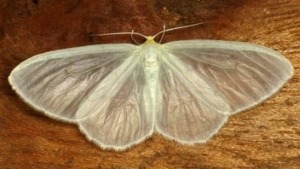By Norah Christianson
Lobocraspis griseifusa
By Ted Kooser
This is the tiny moth who lives on tears,
who drinks like a deer at the gleaming pool
at the edge of the sleeper’s eye, the touch
of its mouth as light as a cloud’s reflection.
In your dream, a moonlit figure appears
at your bedside and touches your face.
He asks if he might share the poor bread
of your sorrow. You show him the table.
The two of you talk long into the night,
but by morning the words are forgotten.
You awaken serene, in a sunny room,
rubbing the dust of his wings from your eyes.
Kooser’s poem, “Lobocraspis griseifusa,” is a little jewel of a poem—sweet, mysterious, and magical. It delights. In the poem, the sleeping person whose tears are being sipped is you. The moth touches your face, an actual physical stimulus, which then enters into your dream as a “moonlit figure.” (Often, an outside stimulus will enter and commingle with your dream. For instance, a real dog barking at the stars outside might enter into your dream as a rescue dog leading you down a snowy mountain.)
In the poem, the moonlit figure asks if he can share your “poor bread,” your sorrow. You sit at the table with him and talk long into the night. (Science tells us dreams can last from ten minutes to over an hour.) Come morning you wake, calm and serene, because the moonlit man has listened to you. There has been the intimacy of the sharing of sorrows. And what could be more intimate than someone sipping your tears? The sharing of your sorrows has been cathartic for you. You have been restored. You brush moth dust from your eyes, even as you do not remember the moth man or his visit.

“Lobocraspis grieseifusa” is not only a lovely poem, but Kooser gives us two science lessons:
- The moth Lobocraspis grieseifusa exists. I could not find a nickname for this strange moth, nor could I, for all my high school Latin classes, translate its name from Latin to English. But the moth is real. Google tells me it is a Southeast Asia moth and it will drink tears from the more placid and tolerant mammals, such as cows, deer, elephants…and us! (The moth’s choice in tears may reflect differences in the chemical composition of tears of different animals.) If the moth sips at a sleeping eye, that will not bother the sleeper. Kooser describes the touch of the moth’s mouth as “light as a cloud’s reflection.” If the eye is open, however, the moth would irritate it. A little.
- Dreams are essential for our mental health. In scientific experiments, participants who are not allowed to dream (having been awakened each time they begin to dream) develop psychotic symptoms. Even nightmares are important. Nightmares are seen by scientists and psychiatrists as helping to relieve stress, helping to better manage stress, and “…to prepare for real-life threats by anxiously anticipating bad things and trying to think of what to do,” says Deirdre Barrett, Ph.D., a dream researcher at Harvard University.

I know many people say they don’t dream. But they do. I dream a great deal. I keep a notebook of my more interesting dreams. I hope I don’t sound completely nuts, but I go to bed excited to dream. The brain has a Movies-While-You-Sleep app. I must confess that, for the most part, I cannot figure out my dreams. But occasionally I can tweak out a message. For instance, earlier this fall I saw a small snake in my yard. Snake. Small. Skinny. Silent. Scared. It whipped away under some rocks, leaving me with “zero at the bone” (Emily Dickinson), blood pressure at 180/110, and the fear that I would dream about it (because that’s what I do). I am not a fan of snakes. I was not looking forward to bed that night.
But I did not dream of even one snake. Nor the next night. But, on the third night, I dreamed a long dream of many snakes in a pile in my living room. Happy snakes. Beautiful snakes. They were dancing, floating around like ribbons in a wind. And I felt happy. I played with them for a long time before trying to get them into a cardboard box (they resisted, there was a lot of wrangling). I woke up before I could succeed. The thing is, I woke with a smile. This was not a nightmare, as I would have predicted. And I thought, over coffee, that maybe the message of the dream was: “Snakes are happy little fellas. No need to be afraid. You be happy, too.” I do believe it was something like that, a message from my amygdala and my subgenual anterior cingulate cortex. (However, that is not to say I’m now a believer that snakes just wanna have fun. I got the message, but I need to think on it.)
So Kooser has not only written a beautiful poem, but has introduced us to the existence of a special moth, and taught us that dreams can heal us. Ted Kooser: scientist, psychiatrist, magician, POET.
Ted Kooser was born in Ames, Iowa on April 25, 1939. In high school, he had a passion for cars and belonged to the Nightcrawlers Car Club. After college, Kooser worked at Bankers Life Nebraska, and then went on to work for Lincoln Benefit Life (a subsidiary of Allstate) for 35 years before retiring as vice president at the age of 60. While working, he wrote for an hour and a half before work every morning. By the time he retired, Ted Kooser had published seven books of poetry. In 2004, he was named Poet Laureate, and in 2005 he received the Pulitzer Prize for Poetry for his book Delights & Shadows. Kooser lives on an acreage near the village of Garland, Nebraska.

